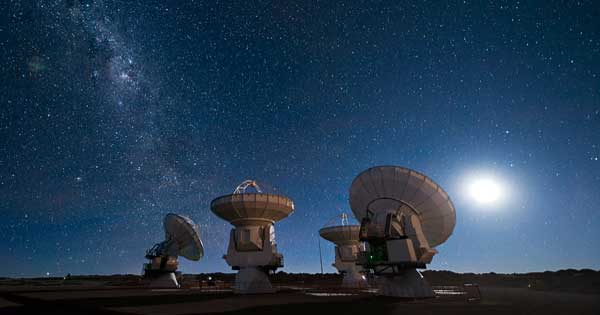
I am no domestic goddess. Given a choice between sweeping up the fine mist of dust that drifts daily into our apartment in Israel and settling down on the sofa in a kimono to read novels and eat bonbons, I’d take bonbons every time. Dust storms are a fact of life in the Middle East: Up to 330 million tons of dust from the Sahara constantly blow around in the wind, causing traffic jams, air pollution, an increase in respiratory disease, and a reduction in visibility that may cause vertigo in airline pilots, according to Haim Kutiel and Hadar Furman of the Department of Geography at the University of Haifa.
I’m inclined to view dust with a little more romance, however, after I read about the birth of a monster star now forming from extremely cold dust and gas in the depths of the Milky Way. Located 11,000 light years away in an area known as the Spitzer Dark Cloud, the colossus, with a mass more than 500 times that of our Sun, is “the largest protostellar core ever spotted in the Milky Way,” according to Nicolas Peretto of Cardiff University, one of several astrophysicists studying the dust-and-gas blob.
To observe formation of the star, the international team used the new ALMA (Atacama Large Millimeter/submillimeter Array) telescope, a set of 66 synchronized radio antennas in the Atacama Desert of Northern Chile. The largest and most sensitive telescope ever built, ALMA “is the perfect tool because it was specifically designed and built for the kinds of observations necessary to understand the formation and very earliest states of the evolution of stars,” says astrophysicist Gary Fuller of Jodrell Bank Centre for Astrophysics at the University of Manchester.
The dust and gas out of which a star forms is impenetrable to light, Fuller explains, so the region where the star is forming must be studied using radiation of much longer wavelengths—millimeter and sub-millimeter—at which dust is more transparent. ALMA is calibrated to observe at these wavelengths, and it can produce very high-resolution images, enabling the astronomers to measure the motion of the gas with exquisite precision.
ALMA’s images reveal that a massive filamentary network of dust and gas is collapsing inward to the core of the cloud. At present the gas is extremely cold—just 10 to 30 degrees Kelvin above absolute zero. But as the gas contracts, and as the cloud becomes denser and denser, energy is trapped inside, raising the temperature. When the cloud reaches 10 million degrees Kelvin, nuclear fusion begins, which will halt the collapse and give birth to a star. “For the kind of massive star we believe is forming,” Fuller says, “the central temperature will probably reach about 40 million Kelvin and the surface 40 thousand Kelvin.”
Fuller says he and his fellow astrophysicists are “very pleased” to be witness to the birth of such a fine and handsome star. If I could find anything as scintillating in all my household dust, I’d feel the same way.

